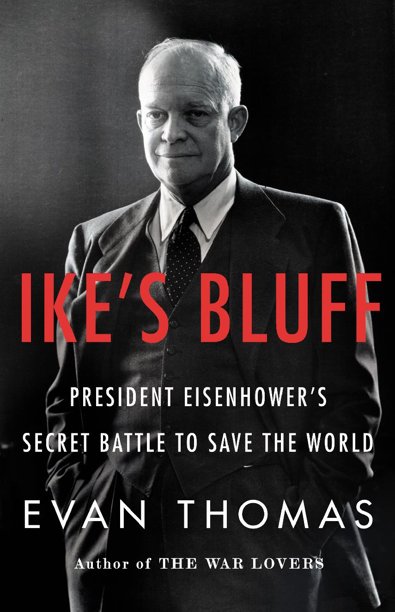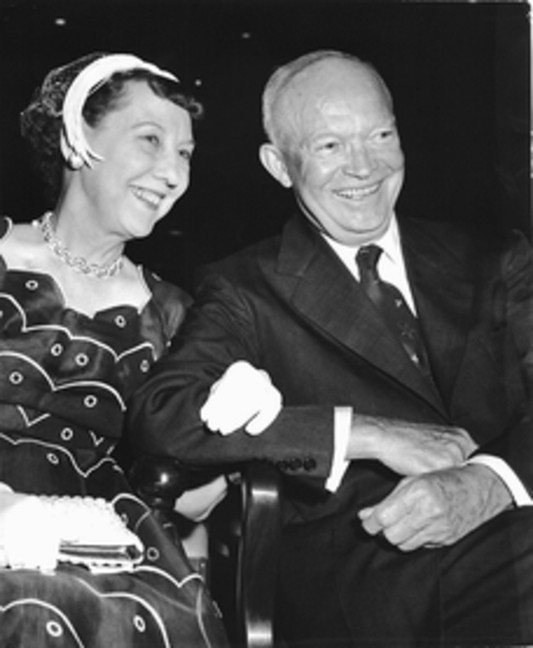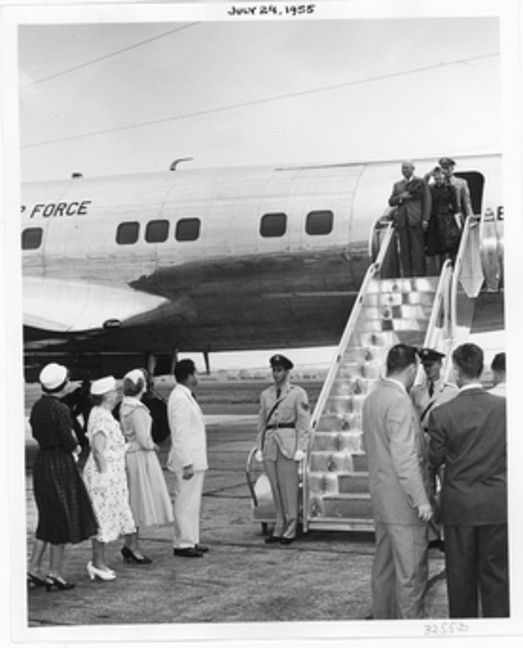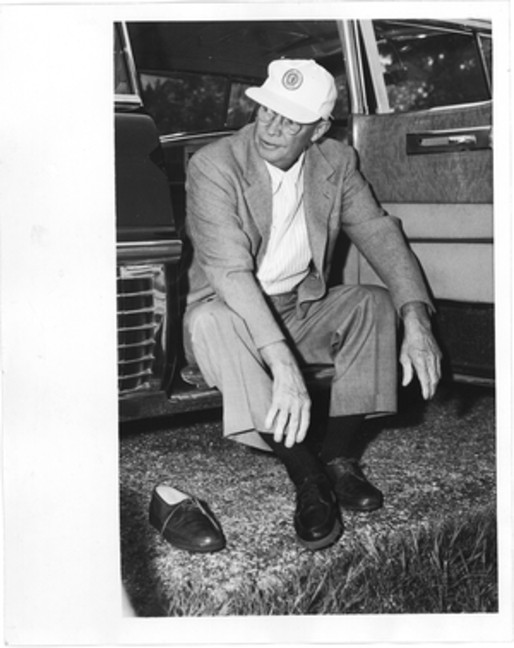 Little, Brown & Co.
Little, Brown & Co.
Dwight Eisenhower is the Nikola Tesla of American presidents. No matter how much he is celebrated and admired, his supporters keep insisting that history has given him a raw deal.
To them, Ike is more than the forgotten man: he is the got-the-shaft man. He has been cheated by a villainous set of academics, historians and journalists who are determined to bury Ike’s presidential genius under wheelbarrow loads of hooey. He has been falsely tarred as President Nincompoop, they say, the guy who spent his time in the White House playing golf and having heart attacks.
That’s the usual argument. So any reader can be forgiven for picking up Evan Thomas’s new book, Ike’s Bluff, with a sinking heart, because Thomas is clearly in the Ike-got-shafted camp.
But not to worry: Thomas has a bigger story in mind. It’s the story of how Eisenhower used every tool at his command (including, yes, phony befuddlement) to manage the early years of nuclear weapons and keep the world from blowing itself up.
And that story is very interesting indeed.
 Photo courtesy of Little, Brown & Co.
Photo courtesy of Little, Brown & Co.
For Thomas, the Ike-as-idiot story got a nefarious boost from a certain young POTUS elected in 1960:
Granddad in a golf cart, the do-nothing, platitude-spouting, syntax-mangling, over-the-hill oldest man ever to occupy the White House – JFK’s followers and admirers jeered and mocked [Eisenhower], the better to accentuate the vigor and youthful eloquence of their champion. …the hatchet job was one of the most lasting and effective in political history.
But as Thomas shows, that same image was helped along by Eisenhower himself, who as president was deliberately vague about what he was thinking in order to protect his nuclear options.
As the title Ike’s Bluff suggests, Taylor makes heavy use of poker analogies. That’s apt: in his Army days, Ike was such a killer poker player that he had to stop playing after leaving too many fellow officers broke.
The essential poker game for nuclear weapons in the 1950s was finding a way to preserve their military and political power without actually being forced to use them. In the first few years after Hiroshima, it seemed totally possible that America might drop nukes again. They were a deterrent in the Korean War, and after all, they were actually being tested above ground in the Pacific.
But it wasn’t long before stockpiles began building up, rockets began gaining range, and a “limited” use of nuclear weapons became impossible. Under those circumstances, the bluff would only work if the other side was convinced you’d fire all of yours off.
Thomas explains this with a story from John Kennedy‘s first year in office, when JFK asked advisor Dean Acheson how he should be thinking about if and when to use nukes:
Acheson… said that “He believed the president should himself give that question the most careful and private consideration, well before the time when the choice might present itself, that he should reach his own clear conclusion in advance as to what he would do and that he should tell no one at all what his conclusion was.”He should tell no one at all… There is no record of what Kennedy was thinking, but the young president may have gotten his first inkling of the particular solitude of a nuclear-age commander in chief.
“Tell no one at all” is what Eisenhower had been doing for eight years. And one way he made it work was to seem sanguine about the whole idea.
At first he made a show of treating nuclear weapons casually – “like bullets,” Thomas says – to show his willingness to use them. As time went by, Ike moved into a deeper game. By 1959 he was telling Congress that he wanted to actually draw down the 250,000 US troops in Europe by 55,000 men.
“What would these 55,000 men do if we had them?” he asked Republican leaders. He wanted to send a clear signal to the Soviets that the United States was not planning to fight with tanks, troops and artillery. If fighting broke out, the only option was nuclear. But to many congressmen and some of his own advisors, Ike looked as if he was shying away from a confrontation.”
By that point the president was in a particularly confounding set of circumstances: he knew from secret U2 overflights that the Soviet Union was way behind America in missiles and bombs. Yet the press had been shouting that the Soviets were actually ahead — the so-called “missile gap” — and Americans were demanding action. Why wasn’t Ike doing anything?
Eisenhower couldn’t reassure his citizens, or even his diplomats, without giving up the secret of the U2. So he fell back on presenting a placid don’t-worry front, which many mistook for laziness or simple lack of vigor.
And of course, Ike also fell back on his well-documented tactic of giving vague, rambling answers in his press conferences. If he sounded out of touch on specifics, that’s just the way he wanted it. There was nothing to be gained in the great poker game by telling anyone in advance how he might play his hand or how he was playing it at that moment.
 Photo courtesy of Little, Brown & Co.
Photo courtesy of Little, Brown & Co.
Besides being an expert bluffer, Ike was a lifetime Army man who knew exactly how generals thought, how wars were fought, and how things got out of hand. He saw clearly that the first way to prevent nuclear wars was to keep the U.S. out of the smaller wars that could blow up and go nuclear. Taylor shows how Eisenhower maneuvered around incidents like the Hungarian revolution, the Suez Crisis, the Khruschev summit, and the inevitable downing of the U2 with his distinct mix of brains and a no-sweat public persona.
However placid Eisenhower seemed in public, he had a famous temper in private, “the twisted cord-like temple arteries standing out of the side of his head” when he went into a rage.
And if Eisenhower seemed physically infirm, that was no bluff. A heart attack kept him laid up in Denver for an astounding seven weeks in 1955 – yes, while he was president – because his doctor wouldn’t let him fly. And Taylor tracks a long litany of other old-school medical symptoms (gastric upset, high blood pressure, Crohn’s disease, strokes) and cures (rubbing alcohol, enemas, milk of magnesia, scotch).
Even a piece of celery could throw off Ike’s constitution:
Shortly after midnight on June 8, Mamie called Howard Snyder: her husband was experiencing severe stomach distress. Snyder gave Ike some milk of magnesia, then an enema to relieve his gas, but the cure didn’t take. The president’s abdomen became swollen and the pain grew worse. Despite his doctor’s orders to avoid raw vegetables, Ike confessed that he’d asked the White House chef to prepare him a Waldorf salad for dinner.
In that case, the piece of celery stuck in his ileum required emergency surgery. Then later, during the Suez Crisis, things flared up again:
His heart was skipping as many as eight times per minute and his pulse was racing – as high as 90 beats a minute. That night he could not sleep, and called on his indefatigable physician to feel the abdominal scar from his intestinal operation. It was red and distended; Ike feared that it would need lancing to ease an infection. Snyder gave Eisenhower a pill, a mood stabilizer, along with a “tall glass of Scotch and water.”
 Photo courtesy of Little, Brown & Co.
Photo courtesy of Little, Brown & Co.And then there was golf, his great relaxation and escape, so much so that “Eisenhower teed off for a full round of golf about eight hundred times in his eight years as president.” He made 29 visits to Augusta National alone, for weekends and full weeks. If that helped leave the impression of an out-to-lunch president, Eisenhower didn’t seem to mind.
Years later, [Ike’s son] John Eisenhower expressed a kind of bemused wonder at his father’s obsession. He recalled his father’s “glee” as he arrived for his frequent weekends and holidays at Augusta National. “He would change his shoes in the Cadillac,” on the way in from the airport, John recalled.
Presidents always get criticized for their golf, it seems. But however he may have been regarded by journalists, Eisenhower’s public approval ratings were unthinkable today: 70% after a year in office, and as high as 80% later.
In the end, Dwight Eisenhower’s greatest contribution to the nuclear age may be the simplest one: his practical-minded realization that it was ridiculous to game plan as if a nuclear war would be survivable.
At one session on contingency planning for Berlin, an official from the Treasury Department discussed measures to restore the dollar exchange rate after a ‘general war.’ The president cut him off. ‘We’re not going to be worrying about the exchange rate,’ Ike said. ‘We’re going to be grubbing for worms.’
It may not be clear who’s still hating on President Eisenhower these days, but Evan Thomas mounts a powerful defense nonetheless. This is a fine read.
